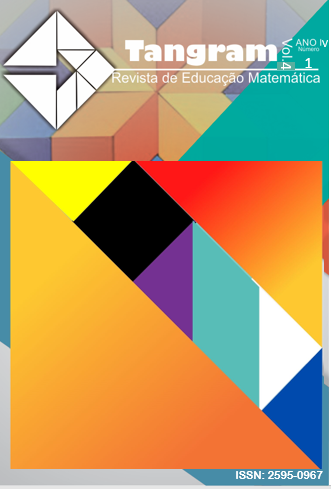Propondo as trilhas de matemática como uma ação pedagógica para a (re)descoberta do conhecimento matemático fora das salas de aula
DOI:
https://doi.org/10.30612/tangram.v4i1.12813Keywords:
Ação pedagógica, Etnomodelagem, Trilhas de matemáticaAbstract
A proposição do projeto das Trilhas de Matemática pode ser considerada como uma proposta pedagógica em que os professores utilizam práticas extraescolares para que os alunos possam perceber o conhecimento matemático aplicado em tarefas realizadas fora das salas de aula, em pontos específicos nas ruas de sua cidade. Assim, existe a necessidade do desenvolvimento de módulos de atividades matemáticas extracurriculares, que têm como objetivo tornar os alunos, ativos e críticos nos processos de ensino e aprendizagem em Matemática por meio de uma análise crítica e reflexiva dos próprios ambientes sociocultural e natural. Esse artigo examina as possíveis relações de uma proposta metodológica focalizada na Etnomodelagem por meio do Programa Etnomatemática e nos pressupostos da Modelagem Matemática em sua perspectiva sociocultural, que buscam auxiliar os alunos na leitura de sua realidade para direcioná-los para uma melhor compreensão de seu entorno através dessas trilhas, possibilitando uma interação aprofundada com o próprio mundo.
Downloads
References
Cortes, D. P. O. (2017). Re-significando os conceitos de função: um estudo misto para entender as contribuições da abordagem dialógica da etnomodelagem. Dissertação (Mestrado Profissional em Educação Matemática). Instituto de Ciências Exatas e Biológicas - ICEB. Departamento de Educação Matemática- DEEMA. Ouro Preto, MG: UFOP.
Cross, R. (1997). Developing maths trails. Mathematics Teaching, 158, 38-39.
D’Ambrosio, U. (1990). Etnomatemática. São Paulo, SP: Editora Ática.
D’Ambrosio, U. (2017). Prefácio. In Rosa, M.; Orey, D. C. Etnomodelagem: a arte de traduzir práticas matemática locais (pp. 13-16). São Paulo, SP: Editora Livraria da Física.
English, L. D., Humble, S.; Barnes, V. E. (2010). Trailblazers. Teaching Children Mathematics, 16(7), 402–412.
Ferreira, R. A. T. (2019). Mathematics trails: opportunities for active learning in mathematics. Conference Paper. ATEE Winter Conference. Braga, Portugal: Universidade do Minho.
Gerdes, P, Socio-cultural bases for mathematics education, UNICAMP, Campinas, 1985.
Kenderov, P., Rejali, A., Bartolini Bussi, M., Pandelieva, V., Richter, K., Maschietto, M., Kadijevich, D.; Taylor, P. (2009). Challenges Beyond the Classroom Sources and Organizational Issues. In: E. Barbeau; P. Taylor (Eds.). Challenging Mathematics in and Beyond the Classroom – New ICMI Study Series 12 (pp. 53-96). New York, NY: Springer.
Kubokawa, A.; Ottaway, A. (2009). Positive psychology and cultural sensitivity: a review of the literature. Graduate Journal of Counseling Psychology, 1(2), 129-138.
Orey, D. C. Projeto trilha de matemática de Ouro Preto: TRIMOP. Ouro Preto, MG: UFOP, 2011.
Owens, K. (2012). Papua New Guinea indigenous knowledges about mathematical concepts. Journal of Mathematics and Culture, 6(1), p. 15-50.
Owens, K., Pattison, J., & Lewis, E. (2003). Organising maths trails. Reflections, 28(1), 27-30.
Rodrigues, J. (2019). Modelagem matemática na perspectiva sociocultural da etnomodelagem. In: Anais da XI Conferência Nacional sobre Modelagem Matemática na Educação Básica (pp. 926-941). Belo Horizonte, MG: UFMG, 2019.
Rosa, M. (2010) A mixed-methods study to understand the perceptions of high school leaders about English Language Learners (ELL) students: the case of mathematics. Tese de Doutorado. College of Education. Sacramento, CA: California State University, Sacramento - CSUS.
Rosa, M.; Orey, D. C. (2007). A dimensão crítica da modelagem matemática: ensinando para a eficiência sociocrítica. Horizontes, 25(2), 197-206.
Rosa, M.; Orey, D. (2009). Symmetrical freedom quilts: the ethnomathematics of ways of communication, liberation, and art. Revista Latinoamericana de Etnomatemática, 2(2), 52-75.
Rosa, M.; Orey, D. C. (2012). A modelagem como um ambiente de aprendizagem para a conversão do conhecimento matemático. BOLEMA, 26(42A), 261-290.
Rosa; M. Orey, D. C. (2014). Brazil: streets of Ouro Preto. In: Barta; J.; Eglash, R.; Barkley, C. (Orgs.). Math is a verb: activities and lessons from cultures around the world (pp. 35-46). Reston, VA: NCTM.
Rosa, M.; Orey, D. C. (2016). Humanizing mathematics through ethnomodelling. Journal of Humanistic Mathematics, 6(3), 3-22.
Rosa, M.; Orey, D. C. (2017). Etnomodelagem: a arte de traduzir práticas matemática locais. São Paulo, SP: Livraria Editora da Física.
Rosenthal, M. M.; Ampadu, C. K. (1999). Making mathematics real: the Boston math trail. Mathematics Teaching in the Middle School, 5(3), 140-147.
Spangler, L. (2004). P.H.Y.S.I.C.S. can be done! Science and Children, 41(6), 30–33.
Toliver, K. The math trail. (2016). The futures channel educational videos and activities. Los Angeles, CA: The Futures Channel. Disponível em: http://thefutureschannel.com/the-math-trail/. Acesso em 05 de outubro de 2019.
Vale, I., Barbosa, A.; Pimentel, T. (2015). Math trails: a rich context for problem posing - an experience with pre-service teachers. Quaderni di Ricerca in Didattica (Mathematics), 25(2), 205-211.
Downloads
Published
How to Cite
Issue
Section
License
Authors must accept the publication rules when submitting the journal, as well as agree to the following terms:
(a) The Editorial Board reserves the right to make changes to the Portuguese language in the originals to maintain the cultured standard of the language, while respecting the style of the authors.
(b) Authors retain the copyright and grant the journal the right to first publication, with the work simultaneously licensed under the Attribution-NonCommercial-ShareAlike 3.0 Brazil (CC BY-NC-SA 3.0 BR) that allows: Share - copy and redistribute the material in any medium or format and Adapt - remix, transform, and create from the material. CC BY-NC-SA 3.0 BR considers the following terms:
- Attribution - You must give the appropriate credit, provide a link to the license and indicate whether changes have been made. You must do so under any reasonable circumstances, but in no way that would suggest that the licensor supports you or your use.
- NonCommercial - You may not use the material for commercial purposes.
- Sharing - If you remix, transform, or create from material, you must distribute your contributions under the same license as the original.
- No additional restrictions - You may not apply legal terms or technological measures that legally restrict others from doing anything that the license permits.
(c) After publication, authors are allowed and encouraged to publish and distribute their work online - in institutional repositories, personal page, social network or other scientific dissemination sites, as long as the publication is not for commercial purposes.






